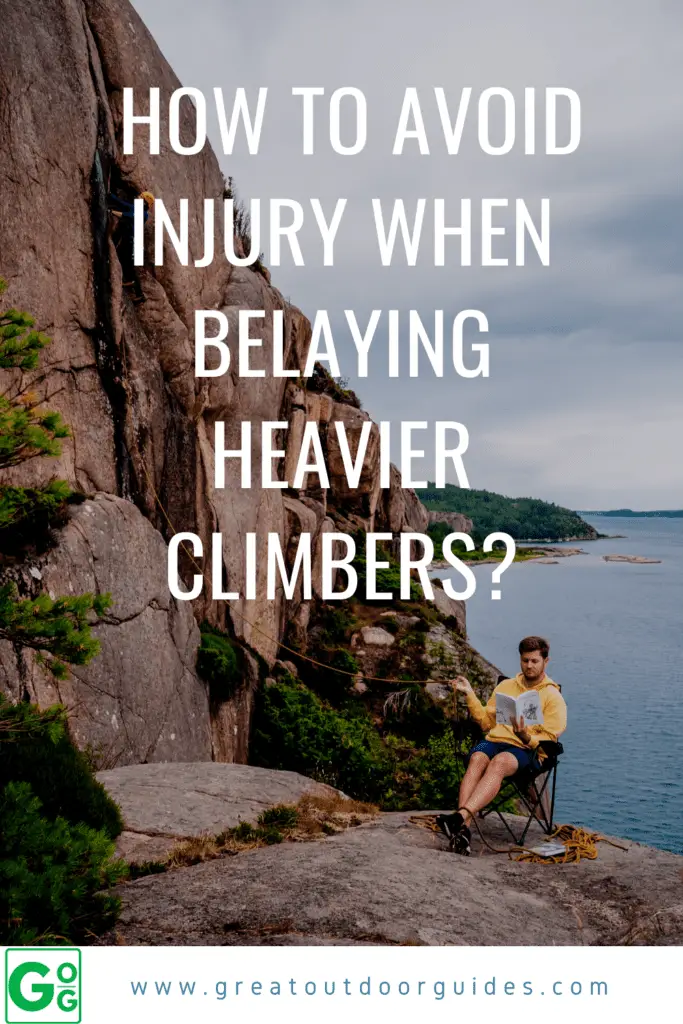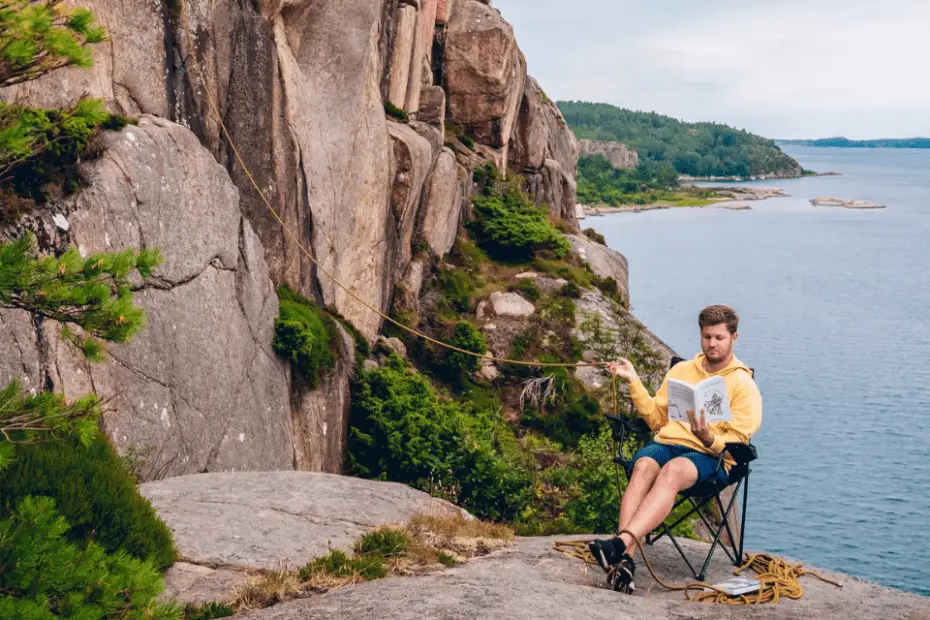My wife and I love doing things as a couple and climbing is something we have always thought would be a great couples activity. The only problem is that we have quite a weight difference between us, so I was worried she wouldn’t be able to belay me if we did go climbing together
I decided to find out all I could about belaying heavier climbers and in this guide I will tell you all you need to know, as well as how to avoid injust when you are belaying someone heavier than you.
If you’re in a rush here’s a quick list of the top tips to belay someone heavier:
- Stand close to the wall
- Don’t stand directly underneath them
- Use an assisted braking belay and an Edelrig Ohm brake quickdraw
- Use thicker rope for extra friction
- Wear protection, such as a helmet, gloves and sturdy shoes
Read on for more tips and how to avoid injury when belaying heavier climbers.
Recommended Gear
Simond Climbind and Mountaineering Helmet | Simond Belaying Gloves | Quechua Waterproof Country Walking Shoe |
Protect your head from falling rock (and climbers) with a helmet. This is also useful for when it's your time to climb as well. | A pair of belay gloves will help you avoid rope burn if the rope quickly moves through your hands in the event of a fall. | Some sturdy shoes will help you stop yourself crashing into the wall and injuring your feet on the rough surface. |
Petzl Grigri Plus Belay | Edelrid Ohm Brake Quickdraw | Simond Climbing Rope 10mm X 70m |
The Petzl Grigri Plus Belay is an assisted braking belay, helping you to slow the fall of the climber much easier. | The Edlerid Ohm is a quickdraw with a built in breaking device. Especially designed for climbing partners with a significant weight difference. | Thicker rope will increase the amount of friction through each of the anchor points, which will help to slow a falling climber down better than a thinner rope. |
Can You Belay Someone Heavier Than You?
Yes, you can belay someone heavier than you. This is possible if they are lead climbing or when they are top-rope climbing. There are certain steps you should take to protect both you and the climber when there is a significant weight difference, which I will cover later in this guide.
How Much Heavier Can You Belay?
As a general guide, below are the rough limits you should work with when belaying a heavier climber:
- Top rope climbing – No more than 150% of your body weight. If you weight 50kg, this means you could belay some at around 75kg. With the increased friction from the top anchor will be enough to reduce the risk of injury up to this weight difference.
- Lead climbing – No more than 125% of your body weight. If you weight 50kg, this means you could belay someone at around 62.5kg. The friction between the rope and the anchor points is reduced when someone is lead climbing, so the weight difference you can belay is reduced.
Any weight differences greater than those above should only be attempted with extra mitigations in place, which I will cover later.
What Are The Risks Of Belaying Someone Heavier Than You?
When belaying a climber heavier that you, there are a number of risks that you need to be aware of:
Belayer Is Lifted Off The Ground
When there is a significant weight difference, if the climber falls off of the wall, the rope will pull you off of your feet and into the air. If there is little friction to slow the climber down when they are falling, their is also little to stop you from shooting high up the wall.
Collision Between Belayer And Climber
This is one of the worst things that can happen when there is a signifcant weight difference. As the belayer, you are pulled up the wall without anything to stop you going up and the climber coming down. In this scenario you are highly likely to collide with the climber, injuring both of you. This is most likely to occur when using a top rope with a significant weight difference between the two of you.
Belayer Hits The First Anchor
If you are belaying someone who is lead climbing, where the rope is running through different anchors or quick draws, there is the risk that you will be pulled into the anchor if the climber falls. This can lead to injuries to your hands where you are holding the rope and could affect your grip on the rope altogether.
Belayer Loses Controll Of The Rope Or Lets Go Of The Rope
If the heavier climber falls off the wall and you are pulled towards the wall at high speed, you might be tempted to put your hands out to protect yourself from slamming into it. Unfortunately, this could be disastrous for the climber as this could allow them to fall much further.
How To Belay A Heavier Climber

Now you know what the risks are when belaying a heavier climber, let’s look at what you can do to mitigate these issues and have a much safer climbing experience:
How To Belay A Heavier Lead Climber
Stand Close To The Wall
In normal circumstances when you are belaying another climber, you will stand back to get a good view of them and see how they are doing up the route.
When you belay someone heavier than you, you should try and stand closer to the wall than you normally would. The reason for this is so that, in case the heavier climber does fall, you are not pull into the wall from far away.
The closer you are to the wall, the less distance you will travel when the rope is pulled and therefore the less likely it is that you will be pull off your feet and potentially hit your head on the wall.
Fingers crossed you won’t be pulled at all!
Don’t Stand Directly Under The Climber
Now you are standing closer to the wall, you should avoid standing directly under the person climbing about you.
If the person climbing were to fall and you’re stood directly below them, the chances are they will either fall on your head, or there is the increased chance that you will be pulled up into the climber and collide with them.
Standing to the side instead of directly underneath them reduces this risk significantly.
Wear A Helmet
The first thing you should do is make sure you wear a helmet to protect your head.
When belaying outdoors, the lead climber might slip and fall due to loose and falling rocks. This poses a risk to you down below as you could get hit on the head by the falling debris. You are also more likely to put your hands up to protect your head if there are things falling from above, which could put the climber at risk if they were to fall and you weren’t holding the rope.
The additional benefit of a helmet is that if the lead climber does fall and there is the chance of a collision, the helmet will soften the potential blow to your head.
Falling rocks will be less of an issue with indoor climbing, but it still might help in case of a potential collision.
Wear Gloves
Wearing gloves is another good way to avoid injury when belaying a heavier climber.
If the heavier climber were to fall whilst you are belaying them, you will need to have a stronger than the normal grip on the rope to help prevent their fall. There is a potential here for you to get rope burn as the rope moves through your hand, which could be the end of your day climbing.
Putting a pair of gloves on is a good way to mitigate this risk. The material of the gloves will take the brunt of the friction if the rope does slip through your hands a little.
For extra protection and assurance, you should ensure that you get gloves that:
- Have a snug fit – This will make it easier for you to grab the rope and won’t feel like a burden when using them.
- Have a high friction surface – Gloves with a material like rubber on the palm will have a much higher level of friction, which will make it easier to grip the rope and stop it slipping through your hand.
Wear Sturdy Footware
Most climbers when belaying another climber will put some comfy shoes on, such as crocs or sliders to avoid damaging their expensive climbing shoes. Whilst this might be ok when belaying a climber of similar weight, you should put some sturdy footwear on when the climber is heavier than you.
This isn’t anything to do with making sure people don’t step on your toes but is actually to protect you in case you get pulled into the wall if the climber falls. Being able to throw your feet out in front of you to stop yourself from slamming into the wall is far easier with proper shoes and they will also protect your feet from getting damaged.
I can’t think of anything worse than flying towards a sharp rock face with bare feet. Ouch!
Use An Assisted Braking Belay
If you have a significant weight difference between you and the climber, it can be quite hard for you to get enough grip on the rope to stop it from sliding through the belay device.
In this circumstance, an assisted braking belay will be a big help. These work by using a cam device inside them so that if there is a sudden pull from the rope as the climber falls, the cam moves to lock the rope in place inside the belay. This doesn’t completely stop the rope from moving, but will significantly slow down the rope moving through the belay.
Using an assisted breaking belay, such as the Petzl Grigri Plus Belay, as well as maintaining a steady brake hand could significantly help you and more importantly the climber in case of a fall.
Use An Edelrid Ohm Brake Quickdraw
Making sure that there is some sort of brake on the belay is one thing, but what if you also have a brake on a quick draw as well?
The Edelrid Ohm is exactly that, a quick draw with a built-in brake specifically designed to be used by those belaying much heavier climbers.
This clever quickdraw works by slowing down the speed at which the rope travels through it, in the event of a sudden amount of motion.
The benefit here is that with a braking belay, you are still likely to be pulled off the ground if the climber falls as the belay will simply stop the rope from moving through the device. With the braking quickdraw, the anchor point that the quickdraw is attached to will take some of that force whilst the quickdraw slows the rope down.
Very clever and a must-have if you are regularly belaying heavier climbers.
Use A Thicker Climbing Rope
The main things you probably think about when it comes to choosing a climbing rope is how long the rope is and how heavy it is. Longer ropes tend to be heavier, as do thicker ropes. As it is often hard to compromise on the length of the rope, the temptation is to buy a thinner rope to save weight.
When belaying a heavier climber, this will actually make it harder for you as the belayer if the climber does fall.
Thinner ropes mean less friction on the quickdraws and anchor points up the climb. Increasing the thickness of your rope will increase the amount of friction and therefore help to slow the climber down if they fall.
This will make the job much easier for you as the belayer.
Skip The First Anchor Point
As long as the second anchor point is at a safe point on the climbing route, the climber should skip the first anchor point.
Skipping the first anchor point will reduce the risk of you being pulled straight into the wall if the climber does fall, and instead you will be pulled up a little first.
As you will be pulled off your feet up to the second anchor point, this will help to slow the climber down and also slow down the speed at which you head towards the wall. The reason for this is that is you are pulled towards the first anchor point, gravity won’t be able to slow you down, whereas if you are being pulled up you will benefit from gravity slowing you down.
Place A Quick Draw On An Adjacent Route
The one is such a simple one you will kick yourself if your have been struggling with the weight difference and haven’t tried it before.
Friction is your best friend when you are belaying a heavier climber, so making the rope move at an angle through the quickdraw will increase the friction on the rope. This will have the effect of slowing the climber down should they fall.
By placing a quickdraw on an adjacent route, say at the first anchor point, you will create an angle for the rope to work though on the main route. This angle will create extra friction on the rope and therefore help you to slow the climber down should they fall.
There is the added benefit that you will be pulled away from the climber if they do fall instead of straight up into them, helping to avoid colliding with them.
This one is probably most easily practiced on indoor climbing walls, but could be possible on popular outdoor routes with lots of anchor points available.
Simple, but so affective!
Use A Ground Anchor
Most of the above methods are designed to limit the injury you could get when lifted off your feet, but what if you could avoid being lifted up altogether?
One way you remain firmly on terra firma is to use a ground anchor.
A ground anchor does pretty much what it says on the tin. It is anchored to the ground and holds you, the belayer, in place. If the climber above falls, the ground anchr will stop you being pulled up towards them, even if they are heavier than you.
You don’t always find ground anchors available when climbing, to sometimes you might have to improvise. You could find a sturdy tree nearby and wrap some rope around it.
Wear Something Heavy
Another way to help you belay someone heavier to to make yourself weight as much as they do.
No I’m not suggesting you try and bulk up, eating as much as you can to gain weight. You should try and wear something heavy to reduce the weight difference.
One way you can do this is to take a spare bag or rucksack with you and fill is with heavy rocks. This will help to balance out the weight difference between you and the climber.
How To Belay A Heavier Climber On A Top Rope
Belaying someone on a top rope who is much heavier than you is far easier than when they are lead climbing as the top rope will provide a significant amount of friction above you.
You should still try and use some of the methods suggested above, as these will help to reduce the risk of injury to you and the climber.
Is Belaying Tiring?

As you will probably already know, climbing can be a physically tiring activity, as well as mentally tiring when trying to find the best route to climb, but what about when you are belaying someone.
Whilst belaying is not necessarily as tiring a climbing, you can get tired when belaying someone as you will have to concentrate a lot whilst they are climbing and will need to be ready should they slip.
Remaining mentally alert for that length of time when you are not being physically active can be very tiring indeed so make sure you take breaks as well as the climber.
Summary
I hope from the above you now feel more confident when it comes to belaying a heavier climber than yourself and have learnt how to avoid injuring yourself and the climber in the process. Just make sure you put appropriate mitagations in place and there is no reason why you should enjoy a worry free climbing experience.
If you liked this guide, please share it on Pinterest. Also, please check out our other guides to all things outdoors.
Happy Climbing (and Belaying)!















